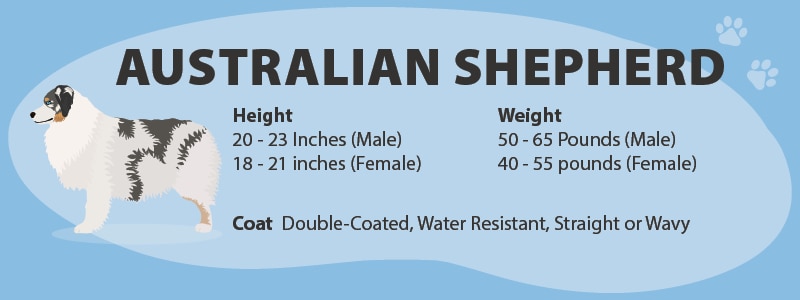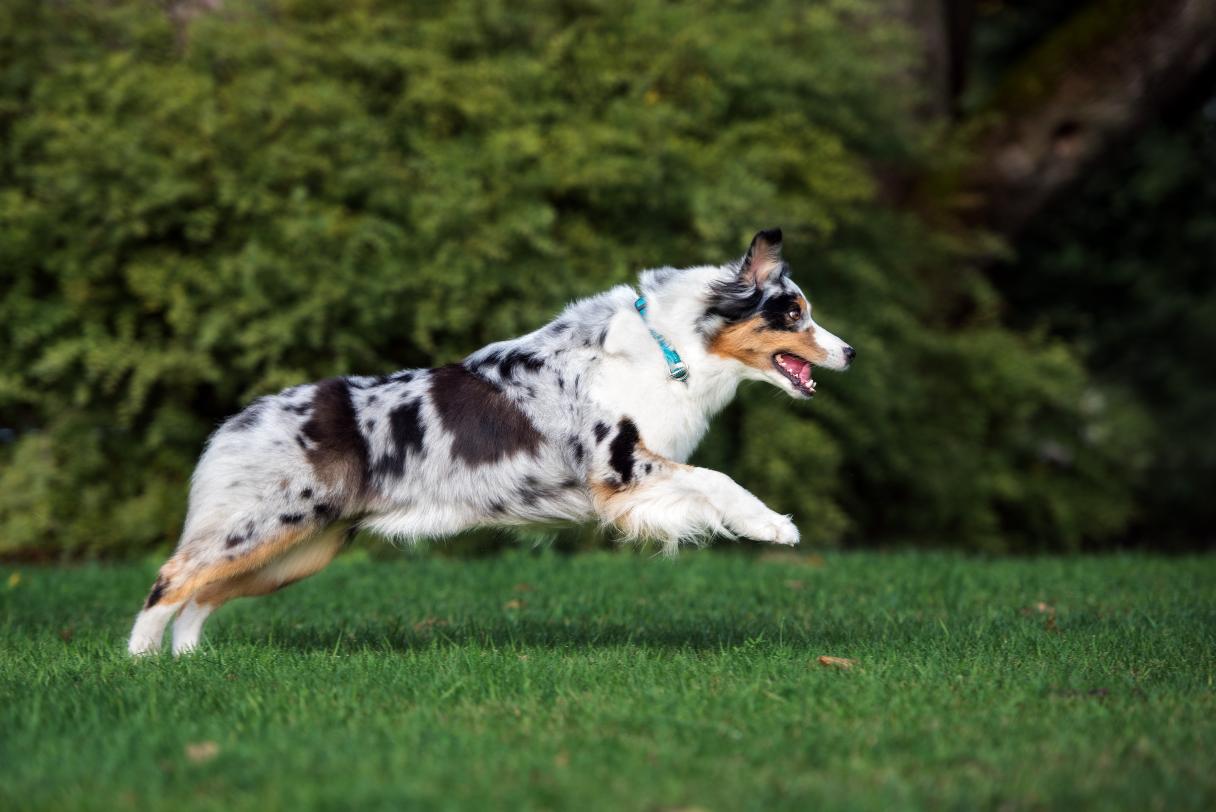Despite the name, the Australian shepherd — Aussie, for short — is more prized for cattle-driving than for herding sheep, although if given a chance they’ll herd just about anything that moves. Beloved by ranchers, this hardworking breed is also a popular rodeo performer that’s highly intelligent and full of tricks. Nevertheless, they can make great pets for families who can keep up with their boundless energy as well as their high engagement and companionship needs.1
Discover more about the Australian shepherd, their temperament and what’s involved in their daily care, as well as their health and wellness needs.
About Australian Shepherds
The history of the Australian shepherd is a bit complex, but one surprising fact is certain: This breed isn’t actually Australian. These are distinctly American dogs who were developed in the Old West from a variety of European herding breeds. Their name comes from the Basque sheepherders and ranch hands who worked with them in the 1800s, who were thought to have arrived in America after first stopping off in Australia to find work.1
While highly valued as working dogs, Aussies exploded in popularity after World War II as the rise of rodeos and Western movies exposed them to a wide audience. Their versatility, easy trainability and unique looks made them equally prized as pets. Not only that, but it was quickly discovered that Australian shepherds excel as service dogs for those with disabilities, as well as police drug dogs and search and rescue dogs.1
Although Aussies began to be recognized by various breed registries in the 1950s, it wasn’t until 1993 that they were officially added to the American Kennel Club’s (AKC) breed registry as members of the herding group.1
Australian Shepherd Appearance

Aussies are medium-sized dogs, with males weighing 50 to 65 pounds and standing 20 to 23 inches at the shoulder.1 Females weigh 40 to 55 pounds and typically stand 18 to 21 inches tall.1 They’re straight-backed and deep-chested, lean and sturdy but not stocky.2
The face is alert and friendly, with triangular ears set high on the head that either flop forward at the tips when alert or fold to the side.2 Their intelligent eyes may be brown, amber, hazel or blue in color.3 Aussies often have two different colored eyes and may even have more than one color in a single eye.3
Aussies have a double coat of medium length with a water-resistant outer layer that may be straight or wavy.2 Their striking coloring comes in four main colors: black, blue merle, red and red merle.4 They may also have white or tan markings and often have both.4
Some Australian shepherd puppies are born with naturally bobbed tails, earning them the nickname “bobtails.”3 Those who aren’t have a long, straight tail.2 However, it’s common for working Aussies born with long tails to have their tails docked, not for cosmetic purposes, but as a safety measure to prevent injuries.1
Australian Shepherd Temperament
Australian shepherds are loving and loyal, responsible and hardworking. They love human companionship and enjoy accompanying their people wherever they can, whether to the bathroom or to run errands. They thrive on companionship but don’t do well being left on their own.4
Aussies are as versatile as they are smart and are happiest when they’re given a job or responsibility. While they’re great at many tasks — including guarding the home or minding children — they love to herd, whether it be livestock or your kids and other pets. They become bored quickly without enough activity, which can lead to destructive behavior. They may also take it upon themselves to guard their owners’ possessions and need training and socialization to keep this tendency from becoming a serious behavior issue.4
Fortunately, training Aussies is easy and fun. They can quickly pick up new commands and learn new tricks, and Aussie puppies are generally easy to house-train. They’re also capable of learning through observation, which means they’re learning from you even when you’re not actively teaching them.4
Living With Australian Shepherds
Australian shepherds are extremely energetic and require significant time and attention, which can make them challenging to handle for people who prefer a more relaxed pace. Here’s what Aussie parents need to know about living with and caring for this breed.
Who they’re best for
Aussies thrive as farm dogs where they can have a lot of different responsibilities and let their talents shine, be it on a large ranch or a small homestead. Barring that, they need to belong to someone who will be happy to have their Aussie constantly by their side and who can keep up with their boundless energy, devoting significant chunks of time each day to training and exercise. Ideally, a prospective Aussie parent will have an occupation that allows them either to stay home or to bring their dog along.4
An Australian shepherd who is well trained in manners and acceptable behavior so they’re not too bossy can be an awesome companion for children who are old enough to assert themselves. However, they may be too exuberant to be around small children without supervision.5
Living space
An Aussie will do best with lots of secure and open space to run and play. If you have a yard, a secure fence is a must. That said, they’re adaptable dogs who can do well in cities and apartments, provided they get plenty of walks and opportunities for play and mental engagement, as well as plenty of companionship throughout their day.5
Exercise and activity
Aussies need an hour or two of exercise and activity each day. If they can’t get that from herding livestock or doing farm chores, then they need a large, fenced yard with plenty of room to zoom around, as well as long daily walks or runs. They also make great hiking buddies, and they excel in agility and other canine sports.1
Aussies also need a lot of mental engagement, which they can get through daily training sessions. This is an eager-to-please breed who loves to show off. Teaching them to perform tricks can both be a great way to bond as well as an excellent way to keep them mentally tired out.1
Grooming
For most of the year, Aussies generally need no more than a weekly brushing to keep their coat looking clean and healthy. However, once or twice a year they go through heavy shedding periods when they’ll need to be brushed more often with an undercoat rake and a wire brush. These dogs like to get dirty, so bathing them whenever they’re covered in mud and muck should be sufficient.1
If they’re not grinding them down by chasing after livestock, their nails will need to be trimmed every few weeks or so. And brushing their teeth a few times a week will help their teeth and gums stay healthy between dental checkups.1
Australian Shepherd Health and Life Expectancy

Australian shepherds live 12 to 15 years on average.1 But a lot of factors can help determine an individual dog’s lifespan, including their genetics, lifestyle, diet and regular healthcare. Keeping them well-exercised, feeding them a quality diet and staying up to date on their vet checkups can all help your Aussie live a long and healthy life.
Aussies do best with dog food that’s suited to their current stage of life. If you decide to feed your Aussie a homemade diet, you should talk to your vet about providing proper nutrition. Otherwise, look for a high-quality commercial dog food that’s approved by the Association of American Feed Control Officials (AAFCO). It’s important to feed your dog the right amount to maintain a healthy weight and avoid obesity, so talk to your vet about the correct amount.1
Overall, the Australian shepherd is considered a healthy breed. While ethical breeders do their best to screen out hereditary health issues, a small percentage of Aussies may still face some health issues that prospective owners should know about.1
Cancer
Australian shepherds have a high propensity for two different forms of cancer:6
-
Hemangiosarcoma. This is a tumor that forms on the spleen and other internal organs that can cause internal bleeding.
-
Lymphoma. A lymphoma is a cancer of the white blood cells that tends to be treatable and typically has good results with chemotherapy.
Cataracts
A cataract is an opaque film on the surface of the eye that can impair vision and eventually result in blindness. In the vast majority of cases, dog cataracts can be removed via surgery.7
Epilepsy
Epilepsy is a neurological disorder marked by seizures with no known cause. In dogs, it’s usually a heritable condition. Canine seizures may be focal, meaning that they’re localized in the brain and can cause odd behaviors like circling or snapping at the air, or general, which causes the entire body to seize up. Epilepsy can usually be managed with medication, and epileptic dogs often live long and otherwise healthy lives.8
Hip dysplasia
Hip dysplasia is a genetic malformation of the hip socket that prevents the ball of the joint from fitting properly into the socket. It can cause dogs a lot of pain and also lead to other joint issues. Mild cases can sometimes be managed via nutrition and lifestyle, while more severe cases will likely require surgical correction.9
Buying or Adopting an Australian Shepherd
AKC-registered Australian shepherd puppies from a reputable breeder typically cost around $2,500, although costs may vary depending on factors such as location and whether the parents are from championship lines. The price typically includes early healthcare, vaccinations and genetic testing.10
Aussies and Aussie mixes of all ages can be found at pet shelters and Australian shepherd rescue organizations. The Aussie Rescue and Placement Helpline, Inc. works with rescues and shelters across the United States to match Aussies in need of good homes with prospective owners. Their nationwide adoption fee is $300.11
Frequently Asked Questions About Australian Shepherds
Still have questions about Aussies? Here are answers to some commonly asked questions about this dog breed.
CareCredit Credit Card Financing for Dogs
Taking good care of your pet's well-being from nose to tail is essential. Make sure to stay up to date on their regular checkups at the vet to help keep your pet happy and healthy for a lifetime of love. You can use your CareCredit credit card for pet care throughout the year for routine veterinary services as well as emergencies and surgeries.* Use our Acceptance Locator to find a veterinarian near you that accepts CareCredit.
CareCredit is there for you and your pet every step of the way; continue your wellness journey by downloading the CareCredit Mobile App to manage your account, find a provider on the go and easily access the Well U blog for more great articles, podcasts and videos.
In addition to pet care, you can also use your CareCredit credit card for dentistry, cosmetic, vision, hearing, health systems, dermatology, pharmacy purchases, spa treatments and so much more within the CareCredit network. How will you invest in your health and wellness next?
Author Bio
Jean Marie Bauhaus is a freelance writer and novelist who has been writing pet content since 2013. Her work has appeared on Forbes.com, Hill's Pet, Chewy, AKC.org and more.















